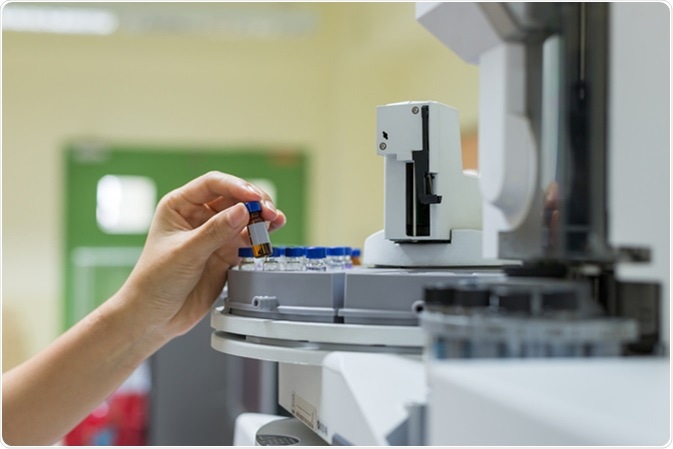How Do You Read Gas Chromatography Results
Gas chromatography (GC) and mass spectrometry (MS) have been combined to become a popular style of analyzing mixtures in nutrient science, forensics, and other research.

Paradigm Credit: Pratchaya.Lee / Shutterstock.com
GC and MS provide distinct but complementary results; while GC separates components of a mixture, MS can clarify and identify these components. These methods were first used in tandem in the 1950s, and are still widely practical in clinics and laboratories worldwide.
GC-MS Chromatogram or Spectrum Development
As expected, the GC step comes earlier MS. For GC, the mixture of interest must be in gaseous form, so the procedure must begin with the conversion of the sample to gas, if necessary. Once in gaseous form, it is passed through a column, besides called the "stationary phase".
The column is lined with material to differentially attract various components of the gas mixture, thereby separating them. They so eluate (emerge from the column) at dissimilar times, and are ionized for the MS analysis. These combine into what is shown equally peaks on a GC-MS chromatogram.
The chromatograms are shown as graphs, with the X-axis showing "retentiveness fourth dimension", and the Y-axis showing "intensity counts". The memory time is the fourth dimension it takes for the component to reach the detector at the end of the column. This makes the results vulnerable to the settings used in the column, such equally menstruum charge per unit and injection temperature.
The aforementioned parameters must therefore exist used, and comparison between different labs or analyses is hard. MS as well analyses the mass to charge ratio, which is also added on as an X-axis component. Therefore, the output of GC-MS can be depicted as a chromatogram, with memory fourth dimension on the Ten-axis, or as a spectrum, with mass to charge ratio on the X-axis.
The Y-centrality, showing intensity counts, is a mensurate of how much quantity of the component is present. The area of the tiptop will reflect how many counts the detector did when the sample reached the MS detection expanse. This can also give misleading results every bit different analytes can accept different affinities for the detector.
Higher affinity will lead to a larger peak surface area, which tin can give a false indication of the corporeality present. However, this tin can be hands solved by running standard curves with known concentrations of analytes.
Gas Chromatography/Mass Spectrometry
Reading Results
The GC and MS components of the analysis provide different bits of information. Memory fourth dimension data provided by the GC forms a manner of identifying the chemic properties of the component. These can be polarity, volatility, and fifty-fifty whether certain functional groups are nowadays or not.
MS provides an indication of the corporeality of the component or analyte present, likewise every bit its molecular weight through the electron ionization mass spectra. The molecular weight is indicative of atomic composition, which can exist of use when deciding how many atoms of a component are present in the molecule.
In certain cases, the composition of the molecule can exist pieced together from the GC-MS results. Many organic compounds will fragment at the MS ion source. These fragments are then read individually for mass. Measuring these fragments can indicate how a molecule's components are connected.
When analyzing information from a mass spectrometry spectrum, two key concepts ascend parent ion tiptop and base top. The parent ion acme, which is besides called the molecular ion top, is the peak that stems from the loss of an electron from the molecule. This represents the mass of the original molecule, since the mass of the electron is so small it is substantially the same as molecular mass.
The base top is the largest peak in the spectrum, which indicates the most abundant component. The base peak is almost always the about stable ion in the mixture considering the affluence is also an indication of ionic stability in the source. The base superlative and the parent superlative can occasionally be the aforementioned.
There have been occasional reports of misidentification of the components using GC-MS. GC-MS is commonly employed in confirming drug examination results from immunoassays, where urine is screened for the presence of drugs such as opiates. Pholcodine is an over-the-counter coughing drug commonly available worldwide.
The structural departure between pholcodine and morphine is small, consisting of only a side chain. Because of this, it has been known to interfere with immunoassays used in drug testing, and can potentially give false positives for opiates. GC-MS has also been shown to generate false positives for opiates when presented with samples containing pholcodine.
When tested, the concentrations also exceed the United kingdom workplace guidelines threshold, and the European union suggested threshold, meaning it can have profound effects on people'southward lives. The moral is that caution is needed when interpreting results, especially in clinical cases.
Farther Reading
- All Chromatography Content
- A Breathalyzer for Cannabinoids?
- Chromatography in Forensic Science
- Combating Counterfeit Green Tea with Metabolomic Profiling
- GC-FID Analysis of CBD and THC
Source: https://www.azolifesciences.com/article/Interpreting-GC-MS-Results.aspx
Postar um comentário for "How Do You Read Gas Chromatography Results"